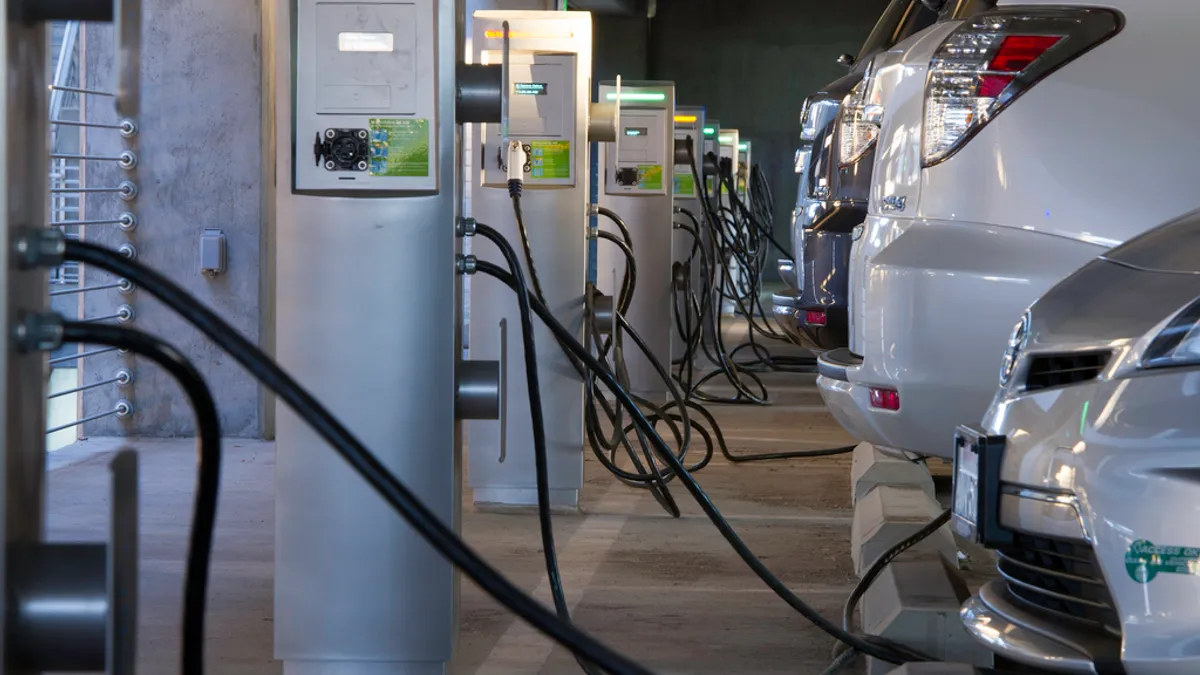Dive Brief:
-
Given the relatively short time frame, cutting U.S. carbon emissions in half by 2030 will require a focus on dispatching existing technologies, including wind and solar but especially electric vehicles (EVs) and energy efficiency, according to a report released Tuesday by the Electric Power Research Institute (EPRI).
-
Electricity will account for 29-33% of total end-use energy consumption by 2030, according to the report. The greatest gains — in both demand and emissions reductions — will come from the electrification of transportation, which will account for 8-16% of electrical demand by the interim deadline, from less than 1% today.
-
To sustain this growth in demand will require the deployment of new wind and solar generation two to three times faster than current norms, plus a 20% increase in inter-regional transmission, the report concludes.
Dive Insight:
Reducing economy-wide carbon emissions 50% over the next eight years will require a significant overhaul of multiple industries and policies — and will need to happen without the benefit of technologies still in development, such as carbon capture, according to EPRI.
Current trends put the U.S. on track to reduce emissions 27% by 2030, compared to 2005 levels, according to the report. While current actions are basically aligned with what EPRI and other researchers believe will be necessary to reach 50% by 2030, getting there will require a significant acceleration of progress, particularly in the electrical and transportation sectors, the report says.
"All the scenarios we're looking at have a lot of change," said Thomas Wilson, a principal technical executive in the energy systems and climate analysis group at EPRI. "In one case, you have the electric sector making an 80% reduction which entails a lot of batteries, solar and wind. On the other hand, with electrification the challenges are very different. We're looking at the preferences of household decisions and businesses that now have to choose EVs vs gasoline, or electric heat vs gas."
With the electrical sector already well on its way, having cut emissions 33% between 2005 and 2019, much of the acceleration will need to come from other industries, Wilson said. Outside electrical generation, he said, the economy as a whole has reduced emissions by just 2%.
"They've all been improving their efficiency because they're sort of treading water on emissions," he said. "But to not just offset growth but get actual emissions reductions, electrification seems key."
The growth of electrification over the next decade will primarily come from transportation, with industry and space heating coming along later, according to John Bistline, a program manager in EPRI's energy systems and climate analysis group.
The results of the EPRI study are consistent with other reports on the topic, according to Daniel Shawhan, a fellow at Resources for the Future, and offer a realistic picture of what it will take to halve economy-wide emissions by 2030.
Trans-regional grid expansion, he said, while not necessarily essential to reaching the 50% target, would help keep costs low by making the most cost-effective renewable resources more widely available. However, he noted that the 2030 timeframe is actually quite short, given that the average transmission project takes more than nine years to build.
With an influx of $65 billion for new transmission lines on its way from the bipartisan infrastructure packaged passed last week, new transmission lines are "hopefully going to come online sooner rather than later," said Edward Hild, a principal in the government relations practice at the lawfirm Buchanan Ingersoll & Rooney. The next challenge, he said, will be dispersing those funds in a timely manner. If energy prices do rise too sharply, he said, it could generate public backlash against future climate ambitions.
"For all of this to happen, everything has to fall into place," Hild said. "And I think we've all seen that this will be difficult."
Correction: We have updated the headline and text of this story to more accurately reflect the contents of the EPRI report.














